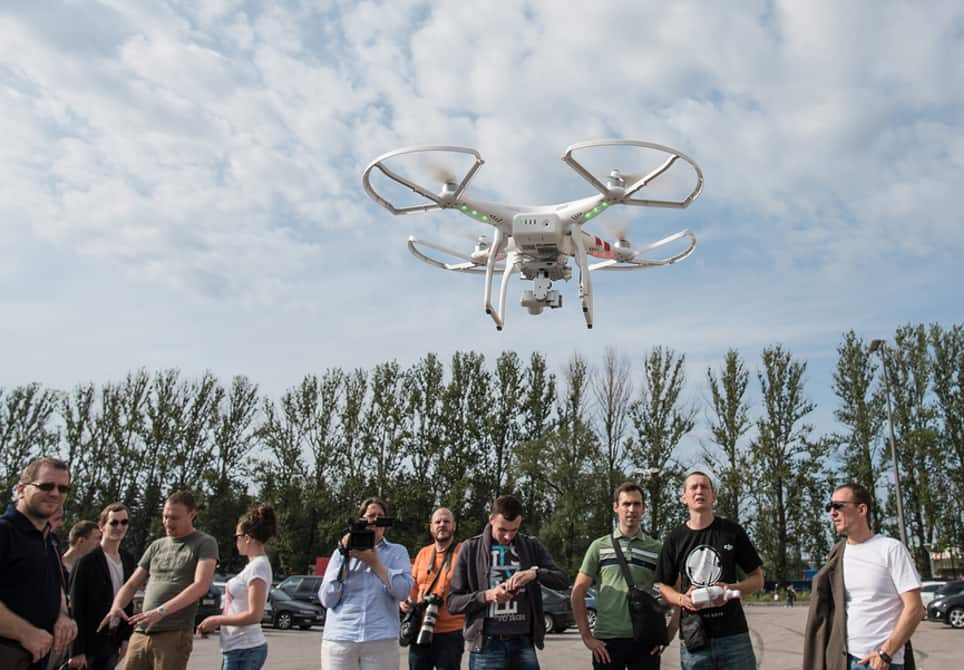Smart Review | Drones in Education: Let Your Students’ Imaginations Soar

Do You Want to Be the Coolest Teacher in the School?
I have to hand it to Chris Carnahan, Laura Zieger and Kimberly Crowley, authors of Drones in Education: Let Your Students’ Imaginations Soar. I’ve never read a claim so bold as the one these folks use in their introduction:
“You are the coolest teacher in the school! That’s what you are going to hear when you walk into your classroom. Simply by purchasing this book, you have demonstrated your level of coolness. Who doesn’t want to fly unmanned aircraft with remote video and photographic capabilities?”
Bold? Yes. True? Very likely.
How to SOAR in Your Implementation
Coolness aside, the book is an excellent primer on drones and how to safely and effectively implement their use in the classroom. The book is strongest when its claims are founded in technology. It would be hard to argue with their logic as they explain: “The challenge with school today is not the content being taught but the manner in which it is being delivered.” Dr. Chris Carnahan and Dr. Laura Zieger, two of the authors, are the creators of a drone implementation model called SOAR, explained in their Table 1.1:
Safety Ethics and legal issues Operation Flight, maintenance and troubleshooting Active Learning Engagement in solving problems Research Practical applications
The book covers these issues thoroughly, as well as taking on some of the more tricky aspects of the education world, particularly Common Core standards and equity for example. They assert that high interest activities which involve math and science will positively impact student achievement, as well as level the playing field too. They write, “Achievement in STEM subjects is a ladder promoting equity for all ethnic groups and socioeconomic statuses by providing access to academic and career success.” However, they are also realistic. Even amongst their success stories, there is the understanding that, “Wayne is fortunate to be working in a building with extremely supportive administrators who believe in the benefits of implementing technology in education.” This measured understanding makes this book credible from the teacher’s perspective.
Curriculum
The authors provide lesson plans that are more of an outline than fleshed-out day to day explanations. This guideline for teachers wishing to begin implementation is appropriate, and the authors have aligned these ideas to the Common Core. For teachers wishing to use drones, the information in the book about drones will be immeasurably helpful; the lesson plans are going to need further development, but this is a benefit to teachers because they can differentiate as necessary for the individual situation.
The most interesting part of the book for a project based classroom is the potential for student-centered learning experiences. One of my favorite is to write an argumentative essay about using drones in the classroom to monitor testing situations. Though it won’t make you the coolest teacher, it is an inventive way to meld STEM with real world writing.
Funding
One of the biggest questions with all things education, of course, is funding. The authors provide a few ideas–Title I, Title II and crowdfunding such as GoFundMe and DonorsChoose.org. They also mention grants, and due to the novelty of this application of STEM, there is a fighting chance for awards. Ultimately as a teacher, for drones in the classroom to be a possibility there are lots of aspects that need to fall into place, and the authors have thought of them.
The Future
Finally, the book gives the reader a look forward, pointing out the considerable growth in the uses for drones, as well as the number of jobs being generated. I think readers can agree that there is certainly a potential boom, and as teachers this book can help you get out ahead of the crowd–the very definition of cool.
For more, see:
- ‘Reading Reconsidered’ Celebrates the Connection Between Reading and Writing
- Honest Self-Help for Students, Teachers and Learning Professionals
- The Battle For Room 314: Walking the Walk
Stay in-the-know with all things EdTech and innovations in learning by signing up to receive the weekly Smart Update.





Romeo Durscher
Thank you Amber - I will get the book so I can also learn. We have seen over the past 12 months that many educators (and researchers and students) have started to get and utilize this new technology and created lesson plans around the tech. And it's not just for part of science, technology, engineering, art and math - but we are also seeing these drones used in PE, from reviewing training to also doing math after a flight. And of course now we are also seeing coding and app development being done for drones. This is all exciting and together we can learn how to best incorporate this technology to not only educate, and motivate, but also create.
Paul Taylor
Hey, Its really very interesting + informative post. I enjoyed it.
Cheers!
Sam Barnes
Great post Amber.
There's no doubt that the power of flight is always an intriguing topic.
It's great to think that we now have the ability to let students get close up to this kind of technology and see what's really happening.
I think there is huge potential for drones to be used in the classroom - and I'm really intrigued to see how teachers use them in the coming months and years!
Chieu Tran
I worked at a summer camp and taught STEM Drone. My students went blizzard over the drones. Mr. T, please let us fly the drones! Also, my students built highly engineered shoot devices (aka PVC marshmallow gun) to shoot the drones in a drone obstacle course. They went crazy over this one! Drone technology is a powerful teaching tool!!!